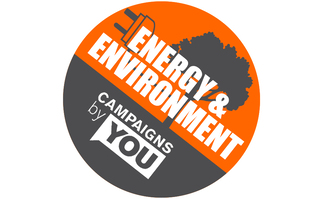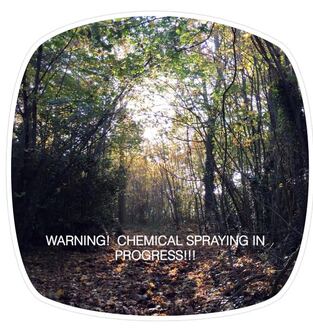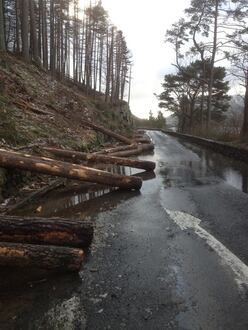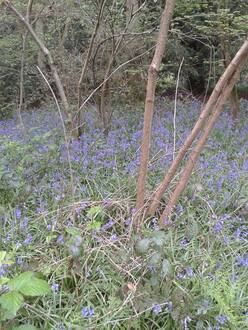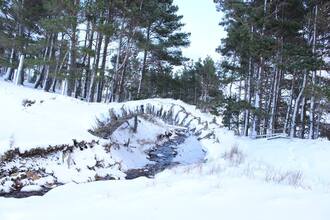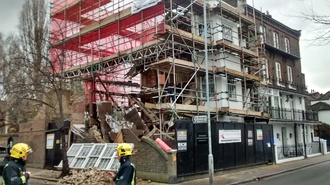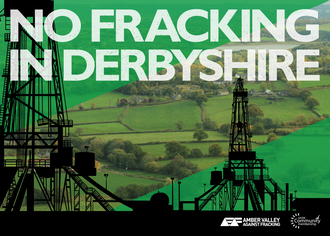-
Stop Fossil Fuel SubsidiesIf we are to stop global warming we need to move away from a Fossil Fuelled society to a world which exists on renewable energies. Renewable energies receive little or no subsidy, whereas Mega Rich MNCs receive millions of £'s in of taxpayers money in the form of subsidies from the British Government. Whereas in reality subsidies should be directed to help with the development of renewable energy services as well as helping people living in fuel poverty become recipients of renewable energies.13 of 100 SignaturesCreated by Pau Bayliss
-
STOP SPRAYING GLYPHOSATE CHEMICALS ON SOUTH GLOUCESTERSHIRE STREETS AND PARKS.South Gloucestershire Council currently uses glyphosate chemical herbicides on our streets and parks despite there being viable safe alternatives and despite the fact that the World Health Organisation (WHO) has identified glyphosate as likely to cause cancer in humans. The WHO finding sits alongside a wealth of existing evidence that raises alarming questions marks over the long term safety of exposure to glyphosate both on its own and in combination with other chemicals found in formulas such as Roundup. The use of glyphosates has already been banned or restricted in 8 countries. It is not acceptable that our children, ourselves and the animals we share this county with are being routinely exposed to these chemicals whether we like it or not. The Council needs to exercise the precautionary principle and follow the example of cities such as Chicago, Paris and Rotterdam by banning this spraying in public places. This is a matter of great importance and urgency for those of us who care about each other's health and the health of our children, our dogs and cats and all the flora and fauna of this county, and of course including our beloved bees. There are viable safe alternatives to glyphosates. The Netherlands have outright banned glyphosates in public spaces and are using a hot water treatment instead. A hot water and foam method is also available in the UK and South Gloucestershire Council is already aware that this can be a more effective alternative than hot water on its own. Glyphosates are the cheapest option but we must send the message loud and clear that value is not just about price and that the health and safety issues around glyphosate render its 'cheap and easy' status irrelevant. Other effective methods may cost more in cash terms but represent far better value to local residents. Using a formula such as glyphosate or Roundup in our public spaces is simply unacceptable no matter how cheap and quick it makes the task of urban weed management. Other European cities have already banned them and now Glastonbury have paved the way here in the UK and have now banned glyphosates and are implementing the foam/hot water method instead. At their next meeting, Bristol City council will vote on whether to do the same following a petition that was handed in on 19th January. People-power stopped these pesticides elsewhere - can 38 Degrees members in South Glos stop them here too? If you think chemical pesticides, that have serious health concerns, no longer have a place on the streets of South Glos then please sign the petition and also email your local councillor and request that they stop spraying outside of your property and all areas! You can find your councillor details here: https://council.southglos.gov.uk/mgMemberIndex.aspx Further information can be found in the following links: The Guardian: Glyphosate is a 'probably carcinogenic' pesticide. Why do cities still use it? http://www.theguardian.com/cities/2015/apr/21/glyphosate-probably-carcinogenic-pesticide-why-cities-use-it The Independent: Glyphosate: Scientists urge caution over experts' claims pesticide is 'probably' carcinogenic: http://www.independent.co.uk/news/science/glyphosate-scientists-urge-caution-over-experts-claims-pesticide-is-probably-carcinogenic-10397787.html A safer non-toxic option is now used: http://www.centralsomersetgazette.co.uk/Glastonbury-takes-look-town-s-weed-problem/story-27651682-detail/story.html Bristol Council Website: A motion to ban the use of glyphosates will be voted on at the full council meeting after a petition was handed in on 19th January: https://www2.bristol.gov.uk/committeeMeetingFinder The Bristol Cable https://thebristolcable.org/2015/10/bristol-monsanto-and-chemicals/1,373 of 2,000 SignaturesCreated by Sonia Adrissi
-
Who profits from disaster in Cumbria?This government have made pledge after pledge , promise after promise to repair the damage from this disaster and to ensure that it never happens again, yet they have kept none of their promises . There is substantial evidence to show that logging has been a major cause of flooding in the region and yet the priority isn't to restore the road for local people but use it to recommence the very activity that caused the problem in the first place. This government has no concern for the environment or local interest but only for profit. It continues to make the same mistakes for its own greed. "The A591 repairs are a blag,it is in working order apart from the GAP which they are not working on,they seem to be concentrating their efforts on forestry operations! Something must be done!!! I saw lots of heavy forestry machinery using the road which is strange as we are being told it is undermined and I saw no evidence of the whole mountain moving!!!" 30 January 2016327 of 400 SignaturesCreated by mike peters

-
#HEATHROW 13The signatories of this petition regard peaceful, direct action as a political right & believe that poeple are entitled to non-violent political protest, as inferred by rights under Article 19 & Article 20 [1] of the UN Universal Declaration of Human Rights: Article 19 Everyone has the right to freedom of opinion and expression; this right includes freedom to hold opinions without interference and to seek, receive and impart information and ideas through any media and regardless of frontiers. Article 20 1. Everyone has the right to freedom of peaceful assembly and association.2,372 of 3,000 SignaturesCreated by Matt Shoul
-
Keep St Silvans car park openPlease help keep this valuable facility open.This car park enables people with children and dogs etc to be able to disembark from their vehicles safely away from moving traffic on the highway. Staffhurst wood is a very popular woods with locals and with visitors from further afield. Offering it's natural beauty all year round (not just bluebell season) it is perfect for walkers, families, runners and dog walkers alike. The woods also have a lot of history as in the war it hid Canadian air men as there was an ammunitions factory in Hurst Green. Although there is another car park, it is the other side of the woods and feels a little bit too remote. Parking in this car park is also made more difficult by the trees growing in the middle of the parking area. The closure of this car park according to Surrey Wildlife Trust is due to the maintenance and up keep costs (this is estimated at £156 per annum !) As a regular visitor of this car park there are always other vehicles there when I arrive and different ones there when I leave. SWT have NOW proposed only seasonal closure and this proposal will incur the costs of welding a hinged bar to the already existing height restriction structure! Also after an email to SCC they have replied stating SWT will be monitoring DISPLACED parking ( at extra cost? ) .Please help keep this car park open and everyone still able to enjoy our great British woodland in safety.465 of 500 SignaturesCreated by Hannah Rose
-
Air Pollution AlertsAccording to Public Health England, the percentage of premature deaths attributable to minute particles known as PM2.5s rose to 5.3% in 2013 in England from 5.1% in 2012. The death rate in London rose to 6.7% from 6.6%. The figures follow significant improvements in air quality across England in 2010 and 2011. The figures were announced as scientists at King’s college London warned of “high” or “very high” particulate pollution across much of London and south-east England for a second day. Seems that this information is only available if you're in the know. Official government figures suggest 29,000 people die prematurely from air pollution a year across the UK from particle pollution emitted by vehicles, central heating systems and dust. Friends of the Earth said: “There must be proper public warnings when there are bad air pollution episodes like today’s - but rather than people having to restrict their activities it must be vehicles which are restricted so that people’s health is protected.” People with heart conditions or breathing problems were advised to reduce exercise and to stay at home. last 2 days7 of 100 SignaturesCreated by deborah tonnesen
-
Demand the SNP state they will ban Fracking in ScotlandOur environment is important to us and it's about time we started to realise this. We need to focus on renewable energy. I believe a stronger stance against fracking would also gain the SNP more support.43 of 100 SignaturesCreated by Paul Rossi
-
Keep Barnsley Frack FreeWe are concerned that fracking could: • Contaminate our water supply • Pollute the air with hazardous chemicals • Cause earthquakes • Reduce the value of our homes • Increase our insurance premiums • Make our roads less safe by increasing heavy traffic • Leak methane, which is a potent greenhouse gas 80 times more powerful than carbon dioxide • Cause illness in local populations • Increase noise and light pollution from drilling operations and traffic movement. Fracking is bad for our environment, bad for our communities and we call upon Barnsley Council to reject fracking in Barnsley.2,896 of 3,000 SignaturesCreated by Andy Hemingway
-
Save the fishing community of Cove HarbourLandowner Pralhad Kohle is trying to prevent fishermen at Cove Bay from using their boats, as people in the community have done since the 1790s. He is trying to evict them and has blocked access with boulders. Cove Bay would not be the place that it is without the harbour. Cove was built and founded on fishing and removing the boats would remove the heart of the village. It would take away people's livelihoods and remove a natural resource from future generations. The local community deserve to keep their heritage, and be allowed to enjoy it.11,318 of 15,000 SignaturesCreated by Claire Adam
-
stop clear felling trees in cairgorms national parkAnimals need woodland habitat. Riversides need trees to help prevent flooding. Humans need trees and the oxygen provided. A lot of these woods have been ignored for about half a century and are now 'semi-natural'. Suddenly timber is very valuable again (woe to woodchip boilers but that is another campaign...) Lovely Scots pine teeming with red squirrels and pine martins and cross bills and so much other wildlife. My home is right beside one of these woods which is earmarked for clearfelling the last of the trees in the immediate area (Corgarff, Aberdeenshire). It is unbearable to imagine the woodland gone and this seems to be the norm across the park. How can we do this in a national park? We criticise people in other parts of the world for clearing forest and still we do it in our own national parks? Lets stop this!!!371 of 400 SignaturesCreated by Sally Scott
-
Stop intrusive basement developmentsThe threat to neighbourhoods and businesses suffering this plague of development show planning rules to be far too heavily weighted in favour of developers. Local residents and businesses, ambushed by ambitious plans, are now often locked out of any consultation process - their rights ignored. Local councils, who they count on to represent their interests are increasingly unwilling to fund legal appeals against their own refusals of planning consent - so give in. Now, not only are homes and businesses put at risk but the quality of life of entire neighbourhoods is vandalised. Innocent property owners should not have to mortgage their livelihoods to fight off the life-style expansions imposed by their neighbours and absent developers. This is wrong and needs to change nationally and locally. Legislation needs to be introduced to persuade or nudge a change in the current property abusing culture. The weight needs to shift in favour of those who need protection against the bullying financial demands of those who assume they can continue, and afford, to override and out-finance their innocent neighbours and local councils and, thereby, impose their encroachments on others. Somehow, a wholesale review of this clash needs to address and reform this injustice, where local authorities decide in favour of developments, regardless, because they are financially restricted, particularly through expensive appeals processes, in affording the costs incurred, to protect their constituents who innocently assume such local authorities might act in their civil interests – many are now disillusioned. As Air Studios fights for its survival, there are other fights against basement plans, including those of the owners of Admiral’s House to safeguard the heritage of Hampstead against plans by the owners of Grove Lodge and the residents of New End to stave off a 3 basement development by the owners of 29 New End. Countless others abound around the country. Something needs to be done against the tyranny of unsuitable basement developments.1,298 of 2,000 SignaturesCreated by Jessica Learmond-Criqui
-
No Fracking in Amber ValleyWe are told that Hydraulic Fracturing (Fracking) will create jobs and lower your energy prices. While this is extremely debatable and has been discredited by many authorities, there are many other environmental and economic facts to be considered. The detrimental effects of Fracking are well documented. Some of the key facts are as follows: Fracking increases local air pollution An increase in risk of pollution to local drinking water supplies Possible Risks of seismic activity Threatens natural habitats Fracking generates massive amounts of greenhouse gases Investments in Fracking blocks the development of renewable energy Increased traffic on roads from site vehicles Potential to lower the value of your house if located near a site for the above reasons Scotland, France and Germany have already banned Fracking. Please help give your support by signing this petition to let the local government that Amber Valley's constituents wish it to remain a Frack free area. Please also see details of our first meeting here: https://www.facebook.com/events/568058916702507/ Or here: https://you.38degrees.org.uk/events/fracking-in-amber-valley1,350 of 2,000 SignaturesCreated by Lee Burrows

Hello! We use cookies to improve your experience by providing insights into how the site is being used. Find out more.
